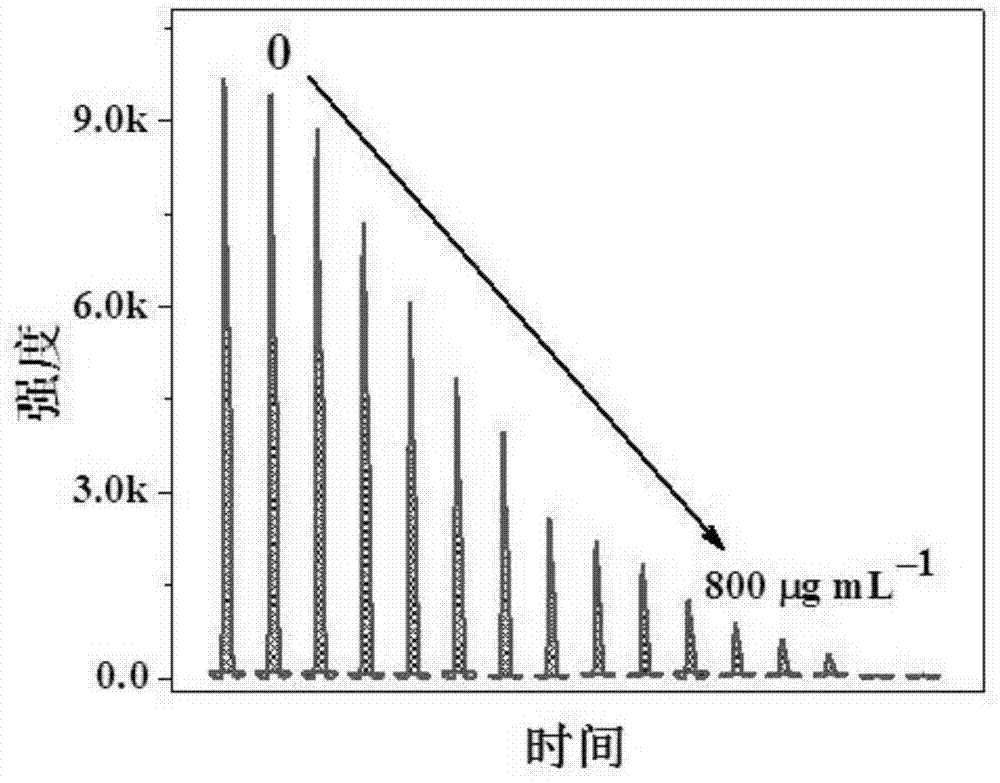An electrochemiluminescent method for detecting graphene oxide
An electrochemical and graphene technology, applied in the field of electrochemical detection, can solve the problems of high technical cost and long processing time, and achieve the effects of high sensitivity, short detection time and low cost
- Summary
- Abstract
- Description
- Claims
- Application Information
AI Technical Summary
Problems solved by technology
Method used
Image
Examples
Embodiment 1
[0025] In the electrochemiluminescence cell that 4mL 0.1M PBS (pH8) is housed, add the 0.1M sodium hydroxide solution that contains 0.01M luminol, after mixing, obtain mixed solution A, wherein the concentration of luminol is 0.01mM, The mixed solution A is scanned for the electrochemiluminescence signal through a three-electrode system at a voltage of -0.3V to 0.8V, a scan rate of 100mV / s, and a photomultiplier tube voltage of 800V to obtain the luminescence of luminol Signal;
[0026] Add different amounts of graphene oxide to mixed solution A in turn, fully dissolve, and mix well to obtain mixed solution B with different GO concentrations; in mixed solution B, GO concentrations are 2.4 μg / mL, 8 μg / mL, and 16 μg / mL , 36 μg / mL, 48 μg / mL, 64 μg / mL, 88 μg / mL, 160 μg / mL, 240 μg / mL, 300 μg / mL, 320 μg / mL and 350 μg / mL, the mixed solution B was passed through a three-electrode system at a voltage of - Under the parameters of 0.3V~0.8V, scan rate of 100mV / s, and photomultiplier tub...
Embodiment 2
[0028] In the electrochemiluminescence cell that 4mL 0.1M PBS (pH9) is housed, add the 0.1M sodium hydroxide solution that contains 0.01M luminol, after mixing, obtain mixed solution A, wherein the concentration of luminol is 0.05mM, The mixed solution A is scanned for the electrochemiluminescence signal through a three-electrode system at a voltage of -0.3V to 0.8V, a scan rate of 100mV / s, and a photomultiplier tube voltage of 800V to obtain the luminescence of luminol Signal;
[0029] Add different amounts of graphene oxide to mixed solution A in turn, fully dissolve, and mix well to obtain mixed solution B with different GO concentrations; in mixed solution B, GO concentrations are 0.25 μg / mL, 0.56 μg / mL, 0.8 μg / mL, 2.4μg / mL, 8μg / mL, 16μg / mL, 36μg / mL, 48μg / mL, 64μg / mL, 88μg / mL, 160μg / mL, 240μg / mL, 400μg / mL and 500μg / mL, for The mixed solution B scans the electrochemiluminescent signals of the mixed solutions with different concentrations of GO through the three-electrode ...
Embodiment 3
[0031] In the electrochemiluminescence cell that 4mL 0.1M PBS (pH9) is housed, add the 0.1M sodium hydroxide solution that contains 0.01M luminol, after mixing, obtain mixed solution A, wherein the concentration of luminol is 0.1mM, The mixed solution A is scanned for the electrochemiluminescence signal through a three-electrode system at a voltage of -0.3V to 0.8V, a scan rate of 100mV / s, and a photomultiplier tube voltage of 800V to obtain the luminescence of luminol Signal;
[0032] Add different amounts of graphene oxide to mixed solution A in turn, fully dissolve, and mix well to obtain mixed solution B with different GO concentrations; in mixed solution B, GO concentrations are 0.08μg / mL, 0.24μg / mL, 0.56μg / mL, 0.8μg / mL, 2.4μg / mL, 8μg / mL, 16μg / mL, 36μg / mL, 48μg / mL, 64μg / mL, 88μg / mL, 160μg / mL, 240μg / mL, 400μg / mL, 560μg / mL and 800μg / mL, for the mixed solution B through the three-electrode system, the voltage is -0.3V ~ 0.8V, the scan rate is 100mV / s, and the photomultipl...
PUM
 Login to View More
Login to View More Abstract
Description
Claims
Application Information
 Login to View More
Login to View More - R&D
- Intellectual Property
- Life Sciences
- Materials
- Tech Scout
- Unparalleled Data Quality
- Higher Quality Content
- 60% Fewer Hallucinations
Browse by: Latest US Patents, China's latest patents, Technical Efficacy Thesaurus, Application Domain, Technology Topic, Popular Technical Reports.
© 2025 PatSnap. All rights reserved.Legal|Privacy policy|Modern Slavery Act Transparency Statement|Sitemap|About US| Contact US: help@patsnap.com


